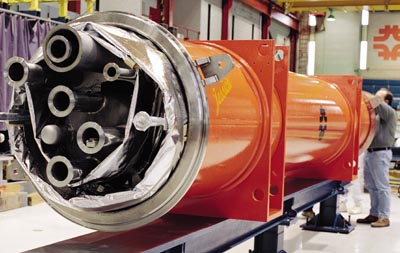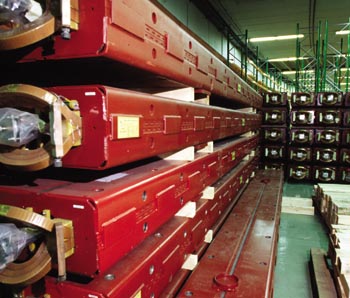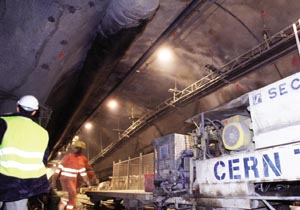As well as the 20 nations of the CERN family, several other nations further afield are making major contributions to the laboratory’s flagship Large Hadron Collider.

The Large Hadron Collider, which is now under construction in CERN’s 27 km ring tunnel, attracts significant contributions from several major nations outside the CERN member state community, making it truly a world machine.
In addition to these important contributions from Canada, India, Japan, Russia and the US, CERN host states France and Switzerland also contribute significant additional resources to the Large Hadron Collider (LHC) above and beyond their natural involvement as part of the 20-nation European CERN community.
Canada
The contribution to the LHC from Canada is valued at C$40 million, much of which is used for hardware to help to upgrade the injector chain, particularly the Booster and the PS synchrotron. This involvement goes back to 1995 and is coordinated by the Canadian TRIUMF laboratory.
Equipment includes ferrite rings and the tuning and high-voltage power supplies for four new radiofrequency cavities for the Booster, which was upgraded from 1 to 1.4 GeV specifically for its new role in the LHC injector chain.
Canadian contributions also include most of the magnets and power supplies for the transfer line between the Booster and the PS, major equipment for the Booster main magnet power supply, and a reactive power compensator to reduce Booster-induced transients on CERN’s electrical supply system.
A second wave of Canadian contribution is mainly for the LHC ring, including 52 twin-aperture quadrupole magnets for “beam cleaning” insertions, together with power suplies for kicker magnets, pulse-forming networks and switches.
Canada will also develop beam-position monitor electronics and carry out some beam optics studies.
India
The initial CERN-India co-operation agreement was signed in 1991 and is renewed every five years. The value of equipment covered is $25 million, of which half is transferred by CERN into a special fund to underwrite further joint ventures.
The main Indian hardware contribution is superconducting sextupole and decapole spool pieces amounting to half of the total LHC requirement for such corrector magnet equipment. In addition, India will supply LHC magnet support jacks and quench heater power supplies.
Circuit breakers are being supplied by Russia, but India remains responsible for the necessary electronics. In addition, India is carrying out several programming and documentation projects.
Japan
Japan’s early entry into the LHC arena in 1995 provided a memorable boost for the project. Japanese contributions currently total approximately ¥13,850 million (some SFr 160 million). Of this sum, some SFr 25 million was earmarked for constructing of the solenoid magnet for the ATLAS experiment (May p8).
The KEK national laboratory acts as a major coordinator for all of this work. Japan is the source of much of the basic material (steel and superconducting cable) for the LHC.
A further significant Japanese contribution to the LHC is the 16 quadrupoles used to squeeze the colliding beams and boost the interaction rate. Also on the list of equipment are compressors for cooling superfluid helium.

Russia
The contribution of the Russian Federation to the LHC machine is valued at SFr 100 million. One-third is channelled into a special fund for CERN-Russian collaboration.
The largest and most visible part of this contribution is the thousands of tonnes of magnets and equipment for the beamlines to link the SPS synchrotron to the LHC. The supply of this equipment from Novosibirsk will soon be complete. Novosibirsk is also supplying insertion magnets for the LHC ring.
The Protvino laboratory is responsible for 18 extraction magnets and the circuit breakers that will receive the electronics from India. The Joint Institute for Nuclear Research, Dubna, is contributing a damping system, and a number of other Russian research centres will furnish a range of items and equipment, including design work, radiation studies, survey targets, ceramic components, busbars and shielding.
USA
Work in the US for the LHC centres on interaction regions 1, 2, 5 and 8, together with some radiofrequency equipment for Point 4. The work is shared between the Brookhaven, Fermilab and Lawrence Berkeley National laboratories.
The impressive list of contributed hardware includes superconducting quadrupoles and their cryostats for beam intersections (Fermilab), superconducting dipoles for beam separation (Brookhaven) and cryogenic feed boxes (Berkeley).
The beam insertion hardware overlaps with that from Japan, and there has been excellent co-operation on LHC contributions between these two industrial giant nations.

Host nations
France and Switzerland, as CERN host nations, make special contributions to the LHC. For France, this includes 218 person-years of work, spread over four major technical agreements, covering the cold mass for LHC short straight sections (handled by the CEA Atomic Energy Commission), the short straight section cryostats and assembly (by the CNRS national research agency), calibration of 8000 thermometers for the LHC (by the Orsay laboratory), and design and series fabrication work for the superfluid helium refrigeration system (CEA).
In addition to this national involvement, the local Rhone-Alpes regional government and the départements of Ain and Haute-Savoie also contribute.
Under the regional government plan, about 90 person-years of assistance will be supplied by young graduates of technical and engineering universities. Haute-Savoie contributes design work on the integration of microelectronics for the LHC cryogenic system.
In addition, the LAPP laboratory at Annecy is developing ultrasonic equipment to monitor superconducting dipole interconnections, and it is doing design work for the vacuum chambers of the major LHC experiments. Ain has contributed the land to build a major new construction and assembly hall next to the CERN site.
The Swiss contribution comes from the federal government and the canton of Geneva, and it covers the cost of a 2.5 km tunnel through which protons will be fed from the SPS to the LHC in the anticlockwise direction.
For the major physics detectors, scientists are used to seeing major equipment being built piecewise in an international jigsaw puzzle, but the LHC machine, too, is taking on such a character.
A path to international contributions was pioneered by the HERA electron-proton collider at DESY, Hamburg, in the 1980s.
For HERA, Canada, France, Italy and the Netherlands supplied components, Israel and the US contributed technological development, and person power came from China, Poland and the UK.







